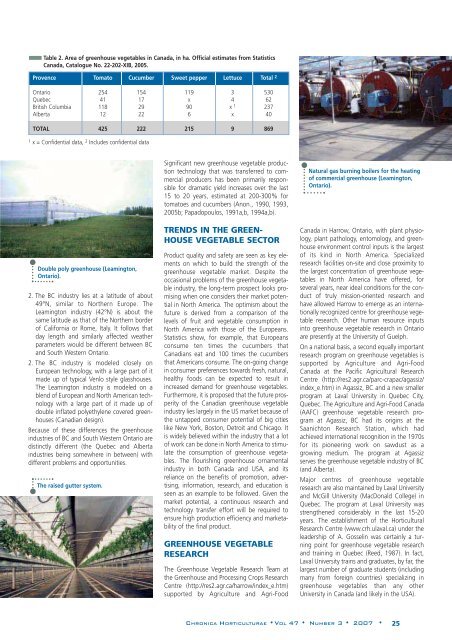Chronica - Acta Horticulturae
Chronica - Acta Horticulturae
Chronica - Acta Horticulturae
You also want an ePaper? Increase the reach of your titles
YUMPU automatically turns print PDFs into web optimized ePapers that Google loves.
Table 2. Area of greenhouse vegetables in Canada, in ha. Official estimates from Statistics<br />
Canada, Catalogue No. 22-202-XIB, 2005.<br />
Provence Tomato Cucumber Sweet pepper Lettuce Total 2<br />
Ontario 254 154 119 3 530<br />
Quebec 41 17 x 4 62<br />
British Columbia 118 29 90 x 1 237<br />
Alberta 12 22 6 x 40<br />
TOTAL 425 222 215 9 869<br />
1 x = Confidential data, 2 Includes confidential data<br />
Double poly greenhouse (Leamington,<br />
Ontario).<br />
2. The BC industry lies at a latitude of about<br />
49°N, similar to Northern Europe. The<br />
Leamington industry (42°N) is about the<br />
same latitude as that of the Northern border<br />
of California or Rome, Italy. It follows that<br />
day length and similarly affected weather<br />
parameters would be different between BC<br />
and South Western Ontario.<br />
2. The BC industry is modeled closely on<br />
European technology, with a large part of it<br />
made up of typical Venlo style glasshouses.<br />
The Leamington industry is modeled on a<br />
blend of European and North American technology<br />
with a large part of it made up of<br />
double inflated polyethylene covered greenhouses<br />
(Canadian design).<br />
Because of these differences the greenhouse<br />
industries of BC and South Western Ontario are<br />
distinctly different (the Quebec and Alberta<br />
industries being somewhere in between) with<br />
different problems and opportunities.<br />
The raised gutter system.<br />
Significant new greenhouse vegetable production<br />
technology that was transferred to commercial<br />
producers has been primarily responsible<br />
for dramatic yield increases over the last<br />
15 to 20 years, estimated at 200-300% for<br />
tomatoes and cucumbers (Anon., 1990, 1993,<br />
2005b; Papadopoulos, 1991a,b, 1994a,b).<br />
TRENDS IN THE GREEN-<br />
HOUSE VEGETABLE SECTOR<br />
Product quality and safety are seen as key elements<br />
on which to build the strength of the<br />
greenhouse vegetable market. Despite the<br />
occasional problems of the greenhouse vegetable<br />
industry, the long-term prospect looks promising<br />
when one considers their market potential<br />
in North America. The optimism about the<br />
future is derived from a comparison of the<br />
levels of fruit and vegetable consumption in<br />
North America with those of the Europeans.<br />
Statistics show, for example, that Europeans<br />
consume ten times the cucumbers that<br />
Canadians eat and 100 times the cucumbers<br />
that Americans consume. The on-going change<br />
in consumer preferences towards fresh, natural,<br />
healthy foods can be expected to result in<br />
increased demand for greenhouse vegetables.<br />
Furthermore, it is proposed that the future prosperity<br />
of the Canadian greenhouse vegetable<br />
industry lies largely in the US market because of<br />
the untapped consumer potential of big cities<br />
like New York, Boston, Detroit and Chicago. It<br />
is widely believed within the industry that a lot<br />
of work can be done in North America to stimulate<br />
the consumption of greenhouse vegetables.<br />
The flourishing greenhouse ornamental<br />
industry in both Canada and USA, and its<br />
reliance on the benefits of promotion, advertising,<br />
information, research, and education is<br />
seen as an example to be followed. Given the<br />
market potential, a continuous research and<br />
technology transfer effort will be required to<br />
ensure high production efficiency and marketability<br />
of the final product.<br />
GREENHOUSE VEGETABLE<br />
RESEARCH<br />
The Greenhouse Vegetable Research Team at<br />
the Greenhouse and Processing Crops Research<br />
Centre (http://res2.agr.ca/harrow/index_e.htm)<br />
supported by Agriculture and Agri-Food<br />
Natural gas burning boilers for the heating<br />
of commercial greenhouse (Leamington,<br />
Ontario).<br />
Canada in Harrow, Ontario, with plant physiology,<br />
plant pathology, entomology, and greenhouse<br />
environment control inputs is the largest<br />
of its kind in North America. Specialized<br />
research facilities on-site and close proximity to<br />
the largest concentration of greenhouse vegetables<br />
in North America have offered, for<br />
several years, near ideal conditions for the conduct<br />
of truly mission-oriented research and<br />
have allowed Harrow to emerge as an internationally<br />
recognized centre for greenhouse vegetable<br />
research. Other human resource inputs<br />
into greenhouse vegetable research in Ontario<br />
are presently at the University of Guelph.<br />
On a national basis, a second equally important<br />
research program on greenhouse vegetables is<br />
supported by Agriculture and Agri-Food<br />
Canada at the Pacific Agricultural Research<br />
Centre (http://res2.agr.ca/parc-crapac/agassiz/<br />
index_e.htm) in Agassiz, BC and a new smaller<br />
program at Laval University in Quebec City,<br />
Quebec. The Agriculture and Agri-Food Canada<br />
(AAFC) greenhouse vegetable research program<br />
at Agassiz, BC had its origins at the<br />
Saanichton Research Station, which had<br />
achieved international recognition in the 1970s<br />
for its pioneering work on sawdust as a<br />
growing medium. The program at Agassiz<br />
serves the greenhouse vegetable industry of BC<br />
(and Alberta).<br />
Major centres of greenhouse vegetable<br />
research are also maintained by Laval University<br />
and McGill University (MacDonald College) in<br />
Quebec. The program at Laval University was<br />
strengthened considerably in the last 15-20<br />
years. The establishment of the Horticultural<br />
Research Centre (www.crh.ulaval.ca) under the<br />
leadership of A. Gosselin was certainly a turning<br />
point for greenhouse vegetable research<br />
and training in Quebec (Reed, 1987). In fact,<br />
Laval University trains and graduates, by far, the<br />
largest number of graduate students (including<br />
many from foreign countries) specializing in<br />
greenhouse vegetables than any other<br />
University in Canada (and likely in the USA).<br />
CHRONICA HORTICULTURAE •VOL 47 • NUMBER 3 • 2007 • 25
















